Stretching — it’s a ritual for many, whether you’re a seasoned athlete, a weekend warrior, or someone just trying to keep the stiffness at bay. The benefits are plentiful: improved flexibility, enhanced circulation, and a reduced risk of injury. Yet, what happens when this very act, meant to relax and rejuvenate your muscles, becomes a source of discomfort? Imagine the frustration when every stretch is met with a twinge or sharp pain in the hip. If you’re reading this, you’re likely all too familiar with that unsettling feeling. This guide delves into the nuances of hip pain during stretching, uncovering the potential causes and, most importantly, the solutions. Because no one should dread the very thing meant to bring relief.
Contents
Common Causes of Hip Pain During Stretching
 Stretching, especially when not done correctly or when one overexerts, can sometimes lead to pain, particularly in areas as complex as the hip. Let’s break down some of the primary reasons you might feel a pinch or persistent pain in the hip during your stretches:
Stretching, especially when not done correctly or when one overexerts, can sometimes lead to pain, particularly in areas as complex as the hip. Let’s break down some of the primary reasons you might feel a pinch or persistent pain in the hip during your stretches:
- Muscle Strains: Overstretching or not warming up properly can lead to muscle strains in the hip area. When the muscles are pushed beyond their limit or when they’re cold, small tears can occur, leading to inflammation and pain.
- Tendonitis: The tendons, which connect muscles to bones, can get inflamed due to repetitive activities or overuse. Hip flexor tendonitis or iliopsoas tendonitis is a common form where the front of the hip hurts during or post-stretching.
- Hip Labral Tear: The ring of cartilage (labrum) that follows the outside rim of your hip joint socket can sometimes tear. This can be due to trauma, structural abnormalities, or repetitive motions. Stretching can exacerbate the pain of a labral tear.
- Hip Impingement: Also known as Femoroacetabular Impingement (FAI), this condition occurs when there’s an abnormal interaction between the hip ball and socket, causing pinching and discomfort, especially during certain movements or stretches.
- Hip Bursitis: Bursae are small fluid-filled sacs that reduce friction between the moving parts in our joints. Inflammation of the bursa in the hip can cause sharp pain, especially during activities like stretching.
- Underlying Arthritis: Conditions like osteoarthritis or rheumatoid arthritis can make the hip joint inflamed and tender. Stretching may aggravate the discomfort in arthritic hips.
- Lumbar Spine Issues: Sometimes, what feels like hip pain isn’t stemming from the hip at all. Issues in the lower spine, like a herniated disc, can refer to pain in the hip region.
Understanding the root cause of the pain is pivotal. If you’re unsure about the cause, consulting a health professional is always the best course of action.
The Importance of Proper Stretching Techniques
Proper technique doesn’t just optimize the benefits of stretching; it can also protect you from injuries and unnecessary pain, especially in areas as sensitive as the hip. Let’s delve into why correct stretching methods are paramount and how they contribute to overall hip health.
- Prevention of Overstretching: By practicing proper techniques, you ensure that you don’t push your muscles and tendons beyond their natural range. Overstretching can lead to micro-tears, which not only cause pain but also require time to heal.
- Uniform Muscle Engagement: Correct stretching engages the muscles uniformly, ensuring that no single part is unduly stressed. This is crucial for the hip area, where multiple muscles converge and work in tandem.
- Enhanced Flexibility and Mobility: Proper techniques help in lengthening the muscles effectively, which, over time, contributes to increased flexibility and range of motion in the hip joint. This makes daily activities smoother and lessens the risk of injuries.
- Improved Blood Circulation: Good stretching habits promote better blood flow to the muscles, ensuring they are well-nourished and oxygenated. This not only aids in faster recovery from minor strains but also keeps the hip muscles in peak health.
- Posture Correction: Regular stretching with the right technique can also correct postural imbalances, which often contribute to hip discomfort. For instance, tight hip flexors from prolonged sitting can lead to anterior pelvic tilt. Stretching can alleviate this tightness and restore natural posture.
- Building a Foundation for Other Activities: Proper stretching readies the body for more strenuous activities. Especially for the hips, which play a pivotal role in many sports and exercises, being well-stretched and limber reduces the risk of sport-related injuries.
In conclusion, while stretching might seem like a straightforward activity, its impact on our body, especially the hip, is profound. Investing time in learning and practicing the right techniques can save you from a lot of pain and complications in the long run. It’s an investment in your health that yields consistent and compounding returns.
The Role of Tight Muscles and Imbalances
The intricate design of the human body relies on a delicate balance of muscle length, strength, and flexibility. When this harmony is disrupted, particularly in areas as interconnected as the hip, discomfort, and pain can ensue. Let’s explore the interplay between these factors and their contribution to hip pain during stretching.
- Tight Hip Flexors: Situated at the front of your pelvis and upper thighs, the hip flexors play a key role in lifting your knees and bending at the waist. Due to sedentary lifestyles and prolonged sitting, these muscles can become shortened and tight. When you then attempt to stretch or engage in activities, this tightness can pull on the lumbar spine, leading to both lower back and hip pain.
- Strained Hamstrings: Tight hamstrings can tilt the pelvis backward, causing a posterior pelvic tilt. This, in turn, exerts undue pressure on the hip joint, making certain stretches uncomfortable or even painful.
- Muscle Imbalances: It’s not just the individual tightness of a muscle that can cause problems; it’s also the relative tightness or weakness of one muscle group compared to another. For example, if the hip flexors are overly tight and the gluteal muscles are weak, it creates an imbalance. Such imbalances can alter the mechanics of the hip joint, making certain movements or stretches feel painful.
- Compensation and Overuse: Tightness in one area often means another muscle group is overcompensating to aid movement. Over time, this overcompensation can lead to overuse injuries in the compensating muscles, adding another source of pain during stretching or activity.
- Inflexibility and Scar Tissue: Previous injuries or lack of regular stretching can lead to the development of scar tissue or inflexibility in certain muscle groups. This makes the muscle less pliable, reducing its ability to stretch without causing discomfort.
In essence, the complexities of the hip, combined with the intricacies of muscular interactions, mean that tightness or imbalances in any single area can have ripple effects, leading to discomfort or pain. Recognizing these underlying issues and addressing them proactively.
Effective Stretching Techniques for Hip Relief
The hip is a complex joint influenced by various muscles and tendons. Stretching can offer relief from discomfort, but it’s crucial to use proper techniques to avoid exacerbating any pain or causing injury. Here are some effective stretches tailored for hip relief:
Butterfly Stretch
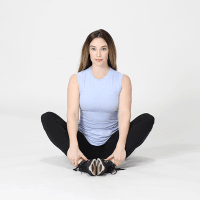
This stretch targets the inner thighs and opens up the hips.
- Sit on the floor with your feet together.
- Hold onto your ankles and allow your knees to drop out to the sides.
- Keeping your back straight, gently press down on your knees with your elbows for a deeper stretch.
- Hold for 20-30 seconds, feeling the stretch in the hips and inner thighs.
Pigeon Pose
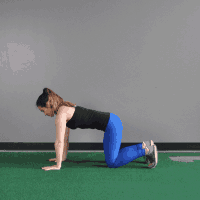
Pigeon Pose is effective for releasing tension in the hip flexors and glutes.
- Start in a plank position.
- Bring your right knee forward, placing it behind your right wrist.
- Extend your left leg straight behind you, toes pointed.
- Sit up tall or lean forward to deepen the stretch.
- Hold for 20-30 seconds, then switch sides.
Standing Hip Flexor Stretch
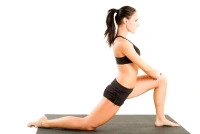
This stretch targets the front of the hip and the hip flexors.
- Stand tall and take a step back with your right foot.
- Bend both knees to lower into a lunge position, keeping the front knee over the ankle.
- Tilt your pelvis forward and engage your glutes.
- Lift your arms overhead for a deeper stretch.
- Hold for 20-30 seconds, then switch sides.
Hip Rotation Stretch
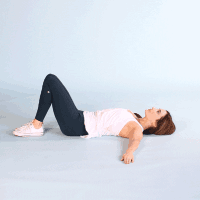
This stretch is great for the outer hip and the glutes.
- Lie on your back with your knees bent and feet flat on the floor.
- Cross your right ankle over your left knee.
- Hold onto the back of your left thigh and gently pull it towards your chest.
- Hold for 20-30 seconds, then switch sides.
Seated Forward Bend
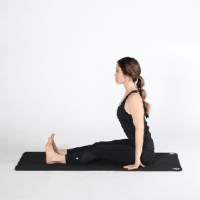 This stretch elongates the hamstrings and lower back, influencing hip comfort.
This stretch elongates the hamstrings and lower back, influencing hip comfort.
- Sit tall with your legs extended straight in front of you.
- Hinge at the hips and reach forward towards your toes.
- Keep your back straight and chest open.
- Hold for 20-30 seconds.
It’s important to approach each stretch gently, without forcing or bouncing. If you feel sharp pain, stop immediately. Regularly incorporating these stretches into your routine can help alleviate hip discomfort, increase flexibility, and contribute to overall hip health.
When to Consult a Professional?
While occasional hip discomfort during stretching can be common, there are certain indicators that it’s time to consult a professional for deeper insights and personalized care. Here’s when to consider seeking expert advice:
- If the hip pain persists for more than a couple of weeks despite rest and self-care measures.
- Experiencing sharp or worsening pain, especially if it’s interfering with daily activities or sleep.
- If you’ve tried various stretching techniques and preventative measures, but see no improvement, it could be an indication of professional attention.
- Difficulty in performing basic activities, such as walking, climbing stairs, or even standing, requires professional intervention.
- If hip pain is accompanied by swelling, redness, warmth, or any unusual symptoms
Benefits of Physical Therapy: Physical therapists are trained to assess, diagnose, and treat musculoskeletal problems like hip pain. They can:
- Provide tailored exercises to strengthen and stretch specific muscles.
- Offer manual therapies to alleviate pain and improve mobility.
- Educate on posture corrections and movement techniques to prevent future issues.
- Use modalities like ultrasound or TENS (transcutaneous electrical nerve stimulation) for pain relief.
In conclusion, while self-care and preventative measures are crucial, knowing when to consult a professional can make the difference between a speedy recovery and prolonged discomfort.
Tips To Prevent Further Discomfort
Hip pain while stretching can be frustrating and limiting, especially for those who are keen on maintaining an active lifestyle. Preventative measures are key to ensuring that the pain doesn’t become a recurring issue. Here are some tips and habits to incorporate into your routine to keep hip discomfort at bay:
- Before diving into any stretches or exercises, ensure you perform a thorough warm-up making your muscles more pliable.
- Allocate time for flexibility exercises several times a week, not just when you feel tight.
- Mind Your Posture
- Strengthening the muscles around the hip, such as the glutes, hip flexors, and core, can provide better support and reduce the risk of overuse injuries.
- Doing the same stretches or exercises every day can lead to overuse injuries. Add variety to your routine to ensure all muscle groups get attention.
- Wearing shoes with proper arch support and cushioning can reduce stress on the hips.
- Once you’ve found a routine that works for you, stick to it. Consistency is key to prevention.
By taking a proactive approach and integrating these habits into your lifestyle, you can significantly reduce the risk of experiencing hip pain when stretching and ensure that your physical activities remain a source of joy and not discomfort.
Conclusion
Navigating the intricate journey of hip pain during stretching can be daunting, but understanding its root causes and seeking the right solutions is the key to relief. Your hip health is essential for maintaining mobility, enjoying daily activities, and living a pain-free life. If you’re experiencing Hip pain, physical therapy for hip pain at PhysioMantra can help: Book an online physical therapy session.



